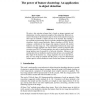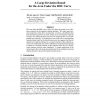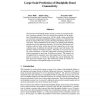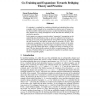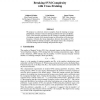102
Voted
NIPS
2004
15 years 2 months ago
2004
We give a fast rejection scheme that is based on image segments and demonstrate it on the canonical example of face detection. However, instead of focusing on the detection step w...
85
Voted
NIPS
2004
15 years 2 months ago
2004
Survey propagation is a powerful technique from statistical physics that has been applied to solve the 3-SAT problem both in principle and in practice. We give, using only probabi...
NIPS
2004
15 years 2 months ago
2004
We describe how we used a data set of chorale harmonisations composed by Johann Sebastian Bach to train Hidden Markov Models. Using a probabilistic framework allows us to create a...
98
Voted
NIPS
2004
15 years 2 months ago
2004
Many interesting multiclass problems can be cast in the general framework of label ranking defined on a given set of classes. The evaluation for such a ranking is generally given ...
104
Voted
NIPS
2004
15 years 2 months ago
2004
The area under the ROC curve (AUC) has been advocated as an evaluation criterion for the bipartite ranking problem. We study large deviation properties of the AUC; in particular, ...
82
Voted
NIPS
2004
15 years 2 months ago
2004
This paper investigates a new learning model in which the input data is corrupted with noise. We present a general statistical framework to tackle this problem. Based on the stati...
100
Voted
NIPS
2004
15 years 2 months ago
2004
First-order Markov models have been successfully applied to many problems, for example in modeling sequential data using Markov chains, and modeling control problems using the Mar...
85
Voted
NIPS
2004
15 years 2 months ago
2004
The formation of disulphide bridges among cysteines is an important feature of protein structures. Here we develop new methods for the prediction of disulphide bond connectivity. ...
130
Voted
NIPS
2004
15 years 2 months ago
2004
Co-training is a method for combining labeled and unlabeled data when examples can be thought of as containing two distinct sets of features. It has had a number of practical succ...
95
Voted
NIPS
2004
15 years 2 months ago
2004
We propose to selectively remove examples from the training set using probabilistic estimates related to editing algorithms (Devijver and Kittler, 1982). This heuristic procedure ...
